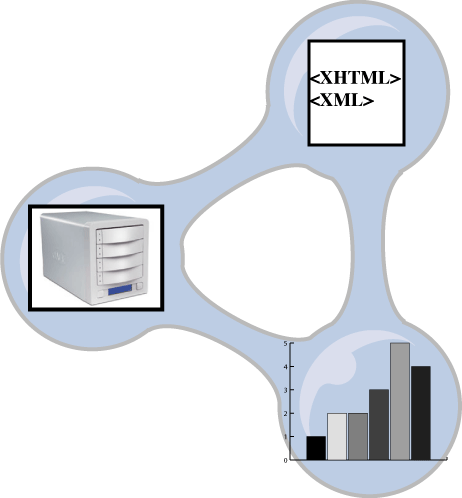Web Evolution not Revolution
Exposing data hiding in documents, servers and databases
Machine Processible data on the Web

International consortium directed by Tim Berners-Lee
Mission: "Lead the Web to its full potential"
Hosts: MIT, ERCIM, Keio University
Defines Web standards: HTML, XML, Web Services, Semantic Web
W3C track record: building infrastructure to address technical and social needs of the Web
Data Integration across application, organizational, community boundaries
Reduces the technical and social costs for effective integration of networked data at various scales
|
Web Evolution not Revolution Exposing data hiding in documents, servers and databases Machine Processible data on the Web |

|
Semantic Web foundation specifications RDF, RDF Schema and OWL are W3C Recommendations as of Feb 2004 (press release and testimonials)
Standardization work is underway in Query and Best Practices.
Strong (and growing) community, vendor deployment
Building upon the foundation that is the basis of a Web of Document to enable a Web of Data
A key element of the Semantic Web
Facilitate integration, derivation, and transformation of data from multiple sources in a distributed, transparent, and scalable manner.
Strong value in treating rules like data, published on the web, using URIs
URIs are used as symbol-constants in a rule language, they can form useful links between knowledge bases
if (* x:presentIn x:Talk) then (* x:ringtone x:off)
x:ringtone owl:sameAs nokia:ringvolume.
Suggestion: Make simple things simple, complex things possible - considered simplfying down and scaling up
Connecting this to W3C specifically
Web Architecture, RDF, OWL - W3C Recommendations
Technical reasons
Social reasons
Technical and Social control points - not boat anchors
Data is King - Freeing the data from the application
Enabling more flexible, customized information services / products
"as needed" data integration
Things change, planing for it is cost effective
Increasingly cost effective to solve closed world problems with open solutions (support IBM / NY Times)
Equally applicable for Rules when treated like Web data